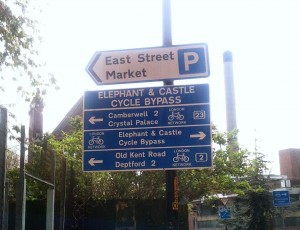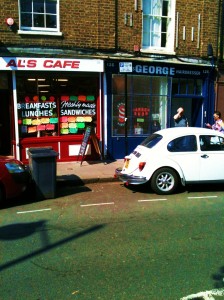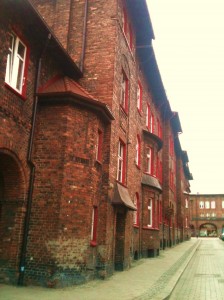They never call it Bermondsey any more
A couple of weeks ago, in Bermondsey, South London with my colleagues Ole Jensen, Simon Rowe and Ida Persson, we met a man called Albert, at the entrance to his council flat. Born on Christmas Day 1926, Albert had lived his whole life in Bermondsey (apart from his national service at the end of the war, spent in Scandinavia). He had lived over half a century in his current flat, since it had been built as part of the massive post-war social democratic housing expansion whose legacy completely dominates the landscape of South London. He worked as a drayman at the Courage brewery, brought up three daughters and a son – and slowly watched his neighbourhood change almost beyond recognition.
The Metropolitan Borough of Bermondsey was merged into the London Borough of Southwark in 1965. Its town hall had been bombed in the war, and Bermondsey no longer exists as an administrative unit. “They never call it Bermondsey any more”, Albert insisted. At its height, the docks employed huge numbers of men; the Peek Frean biscuit factory employed thousands of women. The docks closed one by one from the 1960s, the brewery closed in 1981, and the biscuit factory houses work units for creative businesses. The council estates are no longer sites of utopian hope but now carry the stigma of residualised poverty. A tidal wave of gentrification ripples down from the riverside, and the UK’s decade of mass migration has transformed the demographics.
The anthropologist Gillian Evans talks about Bermondsey in terms of a community’s culture of “lament” for a lost world. That lament came across powerfully in Albert’s interview. His youth was a time of poverty: “We didn’t have nothing”, his 83 year-old neighbour told us, “but then no one didn’t have nothing.” And the war brought bombing and bereavement. But in Albert’s telling, there is nothing better about now than about then. Everything positive is in the past, irretrievably lost; even the identity of Bermondsey is now erased.
In the context of the demographic turbulence of migration, it is impossible not to notice the shadow of race in Bermondsey’s lament. The old Bermondsey (although forged from earlier waves of migration from Ireland and rural England) is recalled as culturally homogenous; the present is seen in terms of multiculturalism. Several people told us that the St George’s flag and St George’s celebrations are “banned” now. Other cultures are celebrated; the “native” one is suppressed. Bermondsey’s lament is interwined with the postcolonial melancholy of post-Windrush Britain.
Post-industrial pastoral
 Bermondsey was one of the London sites of the Concordia Discors research project, which Ole has written about in previous blogposts (1, 2, 3) here. Led by FIERI in Italy, the project worked in eleven European neighbourhoods to understand integration and cohesion at the micro-local level. The London report is on-line here; the comparative European report is here; we will be launching them in the coming month.
Bermondsey was one of the London sites of the Concordia Discors research project, which Ole has written about in previous blogposts (1, 2, 3) here. Led by FIERI in Italy, the project worked in eleven European neighbourhoods to understand integration and cohesion at the micro-local level. The London report is on-line here; the comparative European report is here; we will be launching them in the coming month.
In the project, Ole and I conceptualised Bermondsey’s culture of lament using the notion of “open” and “closed” systems of social interaction developed by anthropologist Sandra Wallman in her ground-breaking London ethnographies. In Wallman’s terms, Bermondsey was a classic “closed” system, with kinship networks, work relationships, and housing provision all densely intertwined, and links to the rest of London constrained. Bermondsey formed something of an island or village in the metropolis, largely endogamous, turned in on itself. When the foundations of the system were swept away in the post-industrial moment, its brittleness was revealed.
Something similar could be seen in another Concordia Discors quarter, Werderau in Nuremburg, researched for the project by the European Forum for Migration Studies, efms, in Bamberg. With a distinctive village-style townscape, Werderau was built for its workforce by the manufacturer MAN. Although, as in Bermondsey, the community was shaped by earlier waves of migration – both internal and from southern Europe – it was remembered as culturally homogenous. When the factory closed and the housing was sold to the private sector (and often bought by upwardly mobile migrants), the brittleness of the system was similarly laid bare. Lars Meier, who was a visiting scholar at COMPAS last year, had worked in Werderau for the European FP7 SPHERE project, and has written about it for a forthcoming special issue of Identities which Mette Berg and Nando Sigona are editing. There, Lars talks about his life history interviews with former MAN workers, which narrate a “figuration” in which the established have lost control of their community to “outsiders”, leading to a powerful affect of displacement and nostalgia.
I visited Katowice in Poland, last month, to present the findings of Concordia Discors to the EUROCITIES Social Affairs Forum, whose meeting focused on neighbourhoods. Katowice, a mining town Silesia, was another SPHERE case study site. At the meeting, we were taken on a study visit to Nikiszowiec, a village on the edge of the city built in 1908 around a colliery by a mining company to house its workers. Again, from internal migration a densely networked homogenous community had been forged in a similarly pastoral townscape; again, privatisation and neoliberal restructuring in the 1990s had led to unemployment and social disorganisation; again, the attractive architecture is now opening the area to gentrification.
In Nikiszowiec, though, we were inspired by an impressive grassroots community organising programme in the neighbourhood, which appeared to have worked to shape a fairly cohesive community despite the fault-lines. Through community organising, different newcomers seemed to be more convivially absorbed into local conviviality. The social disorganisation of the 1990s seemed to have been mitigated to some extent.
Functioning practices
 This brings me to why we were in Bermondsey this month. We were filming for a new FIERI/COMPAS collaborative project, EU-MIA, led by the International Training Centre of the ILO, described by Ole in his post here. The project seeks to document “functioning practices” in local integration. We picked Bermondsey as our pilot, because we felt during the Concordia research that the borough of Southwark’s approach to cohesion and community development in the area offered a positive model of how municipalities can respond to the sort of dislocation described above.
This brings me to why we were in Bermondsey this month. We were filming for a new FIERI/COMPAS collaborative project, EU-MIA, led by the International Training Centre of the ILO, described by Ole in his post here. The project seeks to document “functioning practices” in local integration. We picked Bermondsey as our pilot, because we felt during the Concordia research that the borough of Southwark’s approach to cohesion and community development in the area offered a positive model of how municipalities can respond to the sort of dislocation described above.
Over the period of a decade, the borough has sought to work in partnership with civil society in the area, through the Neighbourhood Renewal and Neighbourhood Management programmes (with which I was involved) to the South Bermondsey Partnership to today’s Big Local programme. At each stage, the council has turned over more power to local residents, while using tried and tested community development methodologies to support them. Intergenerational work and building cohesion out of diversity have been priorities.
We are particularly interested in the council’s support for a resident-initiated St George’s Day carnival. The stigma which Bermondsey people see attached to England’s patron saint – his association with the far right, stories that his flag is banned by multiculturalist municipalities – is the focus of deep local resentment, connected to the culture of lament and postcolonial melancholia discussed here. Working with residents to forge an inclusive, open, civil and convivial St George’s Day seems a much more productive approach to community tensions than a tokenistic “steelbands, samosas and saris” style multiculturalism which feeds the sense of exclusion of the established residents.
Up the Elephant and Round the Castle
 I will finish this post by turning to another new COMPAS project. Welfare, neighbourhood and new geographies of diversity, involving Mette Berg, Caroline Oliver and Nando Sigona (now based at the IRiS, the Institute for Research into Superdiversity in Birmingham). This pilot project seeks to explore some of the issues we have been working on over the last two years around how to “do” the ethnography of urban spaces in the context of the intense “superdiversity” that characterises the present moment.
I will finish this post by turning to another new COMPAS project. Welfare, neighbourhood and new geographies of diversity, involving Mette Berg, Caroline Oliver and Nando Sigona (now based at the IRiS, the Institute for Research into Superdiversity in Birmingham). This pilot project seeks to explore some of the issues we have been working on over the last two years around how to “do” the ethnography of urban spaces in the context of the intense “superdiversity” that characterises the present moment.
In stark contrast to the village-like pastoral settings of Bermonsey, Werderau or Nikiszowiec, we are focusing on a place, less than a mile from Bermondsey, that is more of a non-place: the roundabout at Elephant and Castle, a site of redevelopment and regeneration, of rapid flows of traffic and people, of diversity and churn.
Spending time in both Elephant and Bermondsey in the past weeks has been interesting. The powerful but problematic shared narrative in Bermondsey, exemplified in Albert’s story, seems to be matched by an absence of shared narratives in Elephant. The village space of Bermondsey fits well with an orthodox Malinowskian approach to anthropology – designed to document human life at its tribal scale, however mythical the homogeneity implied in that might be. But there is nothing like this in the hyper-metropolitan space of Elephant.
In such an area, there are challenges for municipal policy-makers – not just in terms of cohesion, but also in terms of the planning, management and delivery of welfare services to such diverse populations. But we are also interested in the challenges for researchers: how do you capture the complexity of social life, when social life is so totally multiple, dispersed and transitory?

